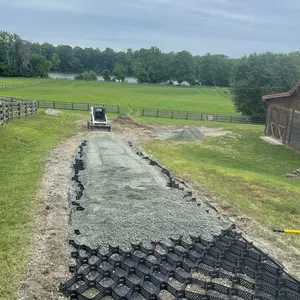
HDPE Geocell Gravel Stabilizers Plastic Honeycomb Geocells For Retaining Wall Reinforcement Slope Protection Driveway Geocell


PVC Drywall Corner Bead Plastic 1-1/4'' Vinyl Stucco Corner Bead Plaster For Gypsum Board Wall Interior





















Plastic retaining walls are structural elements used in landscaping and civil engineering to retain soil or reshape landscapes. These walls are made from durable plastic materials, such as high-density polyethylene (HDPE) or recycled plastics, designed to withstand outdoor conditions and resist degradation from moisture, chemicals, and pests.
Plastic retaining walls offer a range of benefits, making them a popular choice in landscaping and civil engineering projects. Firstly, their lightweight nature stands out as a significant advantage. Compared to traditional retaining wall materials like concrete or stone, plastic retaining walls are considerably lighter, facilitating easier transportation, handling, and installation. This characteristic reduces labor costs and expedites the construction process, allowing for efficient installation even in areas where heavy machinery might not be accessible. Their lightweight also aids in maneuverability during assembly, making them more adaptable to various terrains and configurations.
Durability is another key benefit. These walls are constructed from robust plastic materials, such as high-density polyethylene (HDPE) or recycled plastics, which are designed to withstand harsh outdoor conditions. They are resistant to rot, rust, corrosion, and degradation from moisture or pests, ensuring longevity and minimal maintenance over time. This durability makes plastic retaining walls a cost-effective solution, as they require less frequent repairs or replacements compared to traditional materials like concrete block retaining walls. Additionally, their resilience against weather elements makes them suitable for various climates, offering reliable soil retention and erosion control for different landscaping applications.
Plastic retaining walls find versatile applications across landscaping, civil engineering, and environmental projects. In landscaping, plastic retaining wall panels serve as essential components for creating terraced gardens, leveling uneven terrain, or defining separate areas in outdoor spaces. These garden retaining walls aid in preventing soil erosion, especially on slopes or hillsides, providing structural support to retain soil and prevent its movement. Plastic landscaping retaining walls are commonly used in residential settings for backyard landscaping, creating flower beds, or building raised garden beds, enhancing the aesthetic appeal of outdoor spaces while offering practical solutions for soil retention.
In civil engineering and infrastructure projects, plastic retaining walls play a crucial role in stabilizing embankments, highways, or railways. These walls provide structural support along transportation routes, preventing soil erosion that could compromise the stability of roads or railway tracks. They are also utilized in stormwater management systems, controlling runoff and preventing soil displacement during heavy rainfall or flooding. Additionally, plastic retaining walls are employed in environmental restoration projects, such as riverbank stabilization or shoreline protection, contributing to erosion control and preserving natural habitats. Their versatility and adaptability in various settings make them valuable assets in maintaining structural integrity, preventing erosion, and shaping landscapes in both urban and natural environments.